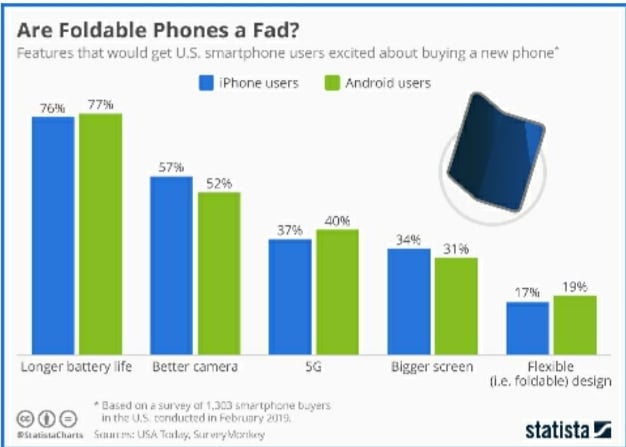Companies have been working on bendable and foldable phones for a while now. Recently, the Galaxy Fold was unveiled by Samsung, with the ability to fold in half without a crease for 12 hours of use.
However, there are still some limitations that make it impossible to completely transform personal electronics – namely battery life and phone functionality. Still, these innovative new options could be promising.
Phone manufacturers are trying to compete in the case of phone design by making their products look different and more memorable. This is evident in the rise of the notch, frames, and other unique features.

(Image Source: Statista)
Samsung’s Galaxy Z Fold has a 7.6-inch display when folded out and a 6.2inch cover display. The screen is flexible and can be unfolded without any creases, though it is not completely foldable. Users will be able to multitask with two separate apps at once using Samsung’s new software.
The folding phone industry will continue its progress with the next generation of technology. It is still hard to predict what this phone industry will look like. The model is still far from perfect, but it gives us hope that companies are working to improve it. Samsung’s Galaxy Fold is a great step forward for technology and cellphones as we know them today.
Folding smartphone limitations
Some of the biggest factors that determine how a phone looks is battery life and the features it can offer. The first obstacle to a completely flexible phone is the battery. Companies have yet to come up with a good solution for a battery that can be folded like paper and still be functional.
Battery weights are usually measured in ounces, while folding phones are measured in grams. Folding phones’ batteries also vary in size, but they’re usually around 2,000 mAh to 4,000 mAh. They are usually limited to six hours of usage when folded and 12 hours when unfolded – not going too far beyond today’s standard smartphones.
There are also some other limitations for the phone’s functionality. In order for you to use a foldable phone, you need to have it unfolded first. This will be problematic if the battery dies while it is folded and you need to access your information or features immediately. For example, if someone calls while the phone is folded, there is no way to detect the call or answer it until you unfold it first, that is ofcourse if it does not have a screen on the cover.
Nevertheless, foldable phones are still a great leap forward in technology and innovation. They could be the future of smartphones, and companies like Samsung are putting in a lot of work to make it. There are also rumours surrounding Apple’s interest in foldable phones, which would mean even more progress and competition.
The Galaxy Fold and Flip might have its limitations but it is still one of the most innovative cell phones ever created. Technology is always changing and innovating. These new developments in technology show that there is a bright future ahead of us.
As the technology for folding smartphones increases, will we begin to see folding tablets? We have already seen many tech giants bring to the market concepts for foldable screens which are wearable but will this technology help revolutionise the tablet market also, allowing 10inch screen tablets to fold down to half the size or unfold into double the size. A folding tablet might not be as thin as a folding smartphone, but it could still be beneficial.
in conclusion , the folding phone revolution is still in its infancy and has a long way to go. This revolutionary technology is not only a great way to use your smartphone on the go, but it will also benefit future generations of smartphones. There are not many folding phones at the moment, but when one does appear, it is sure to resurrect this market.
